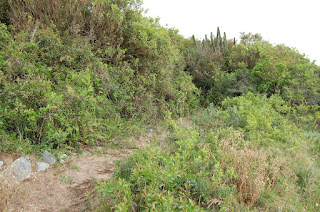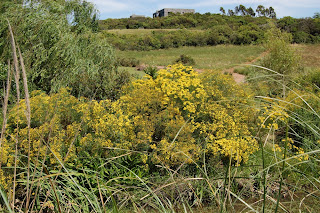Finally - a visit to
La Pasionaria in Uruguay.
I first met Amalia
Robredo in 2007, on a Gardens Illustrated trip to Germany. She was
about as pregnant as it was possible to be before being forbidden to
fly – which I think illustrates something about her determination.
We talked about her interest in using the wild plants of the region
where she lives in her garden design work. Over the next couple of
years I have acted as mentor, offering advice by email and blog, and
she just went on to follow it all and take lots of initiatives of her
own. She even got grants to publish the first ever illustrated guide
to the flowers of the Maldonado Coast, and support further research.
So finally, I get to see how my 'student' is getting on.
-->
Amalia and her
husband Marcelo bought the five hectare property some ten years ago,
as part of a move out of the city into the country; the city being
Buenos Aires and the country the coastline of Uruguay north of the
über-fashionable Punta del Este. Amalia and Marcelo were pioneers,
just outside what was once the quiet fishing village of José Ignacio
(but which is now one of those places where incredibly cool people
eye up other incredibly cool people in shops full of artificially
distressed furniture). They have now been joined by many more, and
the entire coastline between here and Punta (half an hour's drive) is
steadily getting built up. Almost all natural habitat has been lost.
There is not much in eastern Uruguay anyway - several centuries of
cattle rearing and eucalyptus planting have seen to that. Amalia does
very good conventional garden design, but has always wanted to use
locally native plants and preserve or re-create as much of the
natural wild plant communities as possible.
-->
Amalia and
Marcelo's house says something about their respect for the landscape.
Unlike most houses round here which stick out like, well … like the
fantasies of macho architects which many of them are, La Pasionaria
is almost hidden, its granite-block construction making it look like
an old fort. Just peeping above thick woodland its windows give it a
fantastic view over a nearby marshland and lagoon. The woodland in
question is a piece of the local monte.
 |
| A 'mousehole' into the monte, note the cactus poking up as part of the woodland community |
Monte
was the first new word and concept Amalia introduced me to, back in
Piet Oudolf's barn in 2007 when she gave us a short presentation
about her work. It means a kind of dwarf woodland, much sculpted by
wind, almost impenetrable, and in conventional terms, with no
economic value whatever – which accounts for there being not very
much of it left. It includes relatively few species (a berberis is
the only one whose name meant anything to me) but shelters many more,
including ferns and other ground floor species.
Amalia
has learnt how to sculpt the monte, without damaging it. The
Maldonado coast does wind big time, all year round, so once you cut
into the monte you open it up to the wind which can then cause a lot
damage. So she cuts what she calls 'mouse holes' to minimize damage
in the outer skin of the monte where it faces open areas. This skin
is an interesting plant community in its own right: an incredibly
dense mesh of interwoven branches, including some pioneer species
such as various Baccharis
and the incredibly vicious-looking Colletia
paradoxa. The
lower level is a thicket of ferns escaping from the monte understorey
and very dense grass, with a few flowering forbs poking out. 'Inside'
are a number of areas where she has removed the understorey to create
shaded seating areas beneath the intriguing forms of the tree
branches.
 |
| Prado grassland |
The
surviving monte is set amongst grassland, which we would call meadow
– indeed from the distance it could be British meadow grass; get
closer to though and it is clear the grass flora is different and
really very interesting. There are a lot of very attractive grass
species here, which look good not just as border elements but make
quite a show as part of a meadow grass type community. There's a lot
more than just pampas grass!
 |
| Deyeuxia alba, formerly regarded as a Calmagrostis |
Looking
at Amalia's grassland, it's time to learn some more new words: prado
and
pradera. In
fact so useful are these words and the concepts they clothe that I am
seriously considering trying to get them used in English. By prado
she
means grassland which gets cut short through the summer, but is
allowed to grow through the (virtually frostfree) winters to flower
in spring and early summer. The result is a tidy meadow-like
grassland with a rich variety of grasses and about the same
proportion of forbs as might be expected in Britain – mostly yellow
daisy family. The forb (flowering perennial) component of the flora
here is quite limited – beach sand habitats support quite a number
but there is relatively little which consorts with grass. In early
summer, the two most showy and interesting are Vernonia
flexuosa, a
short-growing relative of North America's mighty ironweeds (although
very similar to V. lettermannii,
an
Ozark limestone plateau plant recently launched into commercial
horticulture), and the terrestrial bromeliad Dyckia
remotiflora var. remotiflora,
with
its bright orange flowers. Not showy but a great favourite of
Amalia's is Eryngium
sanguisorba,
which has a large but sparse panicle of tight little dark red
buttons, just like, you've guessed, a Sanguisorba.
In
the strong sunlight of this latitude its hard shape stands out very
well against the grasses.
-->
As
at home, the lower fertility areas of soil support thinner grass and
(possibly) more species. Different grass species dominate different
areas, just as at home, but make considerably more visual impact.
High fertility areas tend to get dominated by European ryegrass
monoculture. The native grasses are mostly of genera familiar to
North Americans, while Melica
brasilensis would
go unnoticed on an Austrian Trockenrasen
(dry
meadow) to all but the dedicated grass lover.
-->
I
did not get to really appreciate Amalia's pradera,
which is a late summer community. Pradera is cut only once a year, or
even less. In fact, Amalia reckons cutting every two years is better
because it allows grasses to build up some good tussocks. The
community which results is much coarser in appearance but includes
some good late flowering perennials, such as several species of
Eupatorium, which
can make a real impact. There is one goldenrod here too – Solidago
chilensis.
 |
| Senecio brasilensis in the unmanaged marshland at the bottom of the property - here be snakes, armadillos and incredibly noisy frogs. |
The
remaining naturalistic habitat at La Pasionaria is essentially
unmanaged, much of it marshland. Cortaderia
(yes!
at last pampas grass!) and Eryngium
pandanifolium
dominates – big rosettes which look a bit like an attenuated agave
which later on produce impressive 2m+ flower spikes. There are a lot
of Eryngium
species here – possibly this is the genus's centre of diversity?
Some are aggressive thistle look-alikes – the aptly named E.
horridum appears
everywhere; most however are garden-worthy. If I were doing serious
plant hunting here, especially focussing on variety selection, I
think I'd start with them (apart from the grasses that is).
 |
| Elionurus muticus - a very variable local grass, well worthy of a place in the garden. |
Education
is a big part of what Amalia does here. Increasingly people are
wanting to come and visit. On this trip we agreed to run a workshop
together, which got oversubscribed very quickly, so we put on another
one a week later. In the workshops
I like to think that we are dancing a tango, except that she (despite
being Argentine) is no more capable of dancing a tango than Jo or I
am. I take the lead and she translates into Spanish, and often adds
her own thoughts, so it is a kind of tango. During a presentation she
does on her own work, before taking around her property, there are
constant interruptions of incredibly lively discussion – people
here are more forthright in their opinions than back home and there
is a great deal of curiosity.
 |
| Erygnium serra |
The workshop was in
her garage, improvised screen for the projector from an old sheet,
and an ingenous home-made flipchart, at times we lean against her car
to do our double act. It goes down incredibly well, the linking of
plant ecology science to gardening is a completely new message.
People are so enthusiastic. Most of the audiences are professionals –
unlike home, almost no 'ladies who lunch'. I feel very proud, and
deeply moved, to have played a part in pioneering a new approach to
garden making here – and so far from home!
 |
| Eryngium sanguisorba (in the wild) |
 |
| Stipa filifolia - another very good potential garden grass |
 |
| Vernonia flexuosa |
and more on her work on The View From Federal Twist blog







1 comment:
Ciao, scopro adesso il tuo blog, è bellissimo, complimenti! Potrò imparare davvero molto :)
Post a Comment